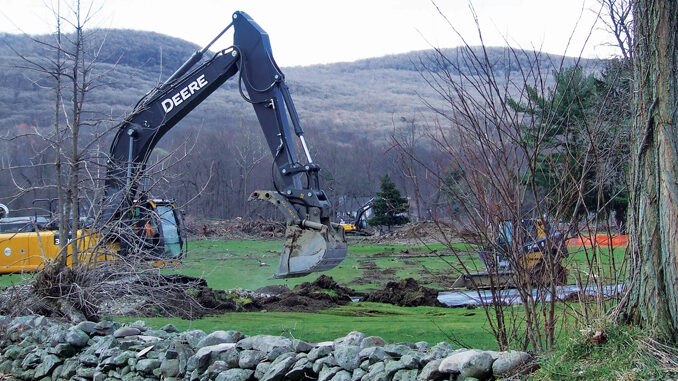
Cornwall residents reacted to widespread removal of trees
By DAVID NOLAND
(In Part One last week, we covered the history and bankruptcy of the Storm King Golf Club, and the subsequent bank foreclosure on the property. The bank ran into an unexpected problem selling off the property because of a restriction in the original deed from the Stillman family that required the property to remain a golf course. Read Part 3 here.)
But just how iron-clad was that Stillman deed restriction? Would the family, now scattered across the country, have the stomach to wage a long, expensive court battle with a housing developer determined to find a way around the restriction? Would a simple financial buyout do the trick? That was the nightmare scenario: the scenic heart of Cornwall clotted with McMansions, or worse.
In 2015, Randy Clark, the former Golf Club member who in the meantime had been elected Cornwall Town Supervisor, proposed that the Town buy the course. Clark figured the property could be bought from the now-desperate bank for about $500,000. He had interest from golf management and restaurant operators, who would pay the town for the right to run the day-to-day operations and make whatever profit they could. Clark’s tentative numbers added up nicely; even accounting for the loss of property tax revenue and payments on a bond toward the purchase, it looked like the Town would make a small annual profit.
Well aware that he had few political allies on the Town Board, Clark asked me to make the formal presentation of his idea at a regular Board meeting. After my dog-and-pony show laying out the basic idea, Clark introduced a motion to further study the possibility of buying the course. Not to buy it. Just to gather some real numbers and open discussion of the matter.
No one else on the Town Board — Bunt, Russell, Longinott, or McGuinnes — would even second the motion. It died stillborn, never to be heard from again. “They threw away a chance to protect the golf course forever,” laments Clark now.
Subsequent Town Supervisor Richard Randazzo later waved off an offer from Trish Hamlin, a wealthy Cornwall woman, to buy the golf course from the bank and donate it to the town. “He dismissed it out of hand,” Hamlin told me. “Said he wouldn’t get re-elected if he increased expenses.”
Randazzo says the problem was that Hamlin’s proposal included some ballfields on the property, which would have violated the Stillmans’ golf-only deed restriction. Hamlin says he never mentioned that objection to her—and that, in any case, she had already broached the idea to a member of the Stillman family, who had seemed supportive of it.
Finally, in 2016, our hoped-for white knight appeared. Mountainville resident and commercial real estate developer Adrian Goddard bought the property from the bank. Goddard, who owns Price Chopper Plaza, is presumably a shrewd negotiator; he managed to pick up the million-dollar-plus clubhouse and 68 acres of land for a reported $465,000.
Goddard seemed to have his heart in the right place. “I think Adrian bought it with the intent to protect it,” recalls a friend of his. He made a number of improvements to the course. For the first time in my memory, the club now had a teaching pro. And, I had to admit, that new clubhouse was pretty nice—especially since the bank had essentially paid for it. Goddard had big plans to pair the clubhouse with a new event facility, the old Stillman tennis pavilion on the adjacent Jogues Retreat property. He didn’t even seem to mind that the kids were sledding on his private property during the off-season. Golfing life in Cornwall, it seemed, had pretty much returned to the good old days.
Then, suddenly, came the chain saws and excavators and the splintering of tree branches. What the heck had happened to our white knight?
What happened was, he got an email out of the blue from a wealthy 50-year-old Texan named Trey Owen. A 1994 West Point graduate, Owen had played on the cadet golf team, leading it to four Patriot League championships and once winning the league individual title. After finishing his Army hitch, Owen was a top amateur golfer, winning 14 tournaments, including the British Amateur in 2002.
In 2010, Owen bought a Planet Fitness franchise in Houston, found success, and started buying more. He now owns more than 180 Planet Fitness franchises (but not the new one in Vails Gate). They have made him a very wealthy man.
Long a supporter of the West Point golf team, Owen wanted to take his support to the next level and provide the current team with “the best collegiate golf facility in the country.” But it had to be near campus. Searching on Google Earth, he was astonished to find the Storm King course right under his nose. “As a cadet, I never even knew it was there,” he says now.
Researching the course, he learned that the West Point golf team had played its home matches at Storm King until the 1940s, when the West Point course was built. That was the karmic clincher.
Owen emailed Goddard, who called back. After some initial discussions about some sort of partnership, Owen offered to buy the course outright.
At the time, Goddard was struggling with what he calls “the appalling economics of running a public golf course.” Moreover, the clubhouse restaurant, despite its superb views and (in my opinion) pretty good food, was “doing nothing.” In the end, Owen made Goddard an offer he couldn’t refuse: $1.75 million.
The deal closed in December 2020. Owen formed a 501(c)3 charitable organization called the Hudson Valley Golf Foundation, and hired attorney Michele Babcock of powerhouse law firm Jacobowitz & Gubitz, and engineer Ross Winglovitz of Engineering Properties in Montgomery.
Owen’s first contact with Town authorities was a brief meet-and-greet Zoom call with Supervisor Randazzo. On January 8, 2021 Owen and his team (Babcock, Winglovitz, and golf architect/construction manager Chris Gray) met via Zoom with Planning Board attorney Dominic Cordisco, Town Engineer Shawn Arnott, Town Planner Kristen O’Donnell, and Building Inspector Gary Vinson in an informal Planning Board work session.
What happened at that meeting can best be summarized by a paraphrase of the iconic line from the movie Cool Hand Luke: What they had there was a failure to communicate.
No written plans were submitted, and the discussions were “general and generic,” in the words of one Town official. Chris Gray of the Golf Foundation agrees. “It was just an introductory meeting.”
Nevertheless, it was agreed that the Planning Board need not be involved in the project. (Those of us who’ve been required to run the Planning Board gauntlet for comparative trifles may be excused a head-slap of astonishment.)
The Town apparently did not have a clear idea of the magnitude of the project. “They were talking along the lines of reconfiguring the tee boxes and the greens,” recalls Town engineer Shawn Arnott. “Based on what was presented, we didn’t feel like the level of grading required Planning Board approval. We assumed there would be minimal changes to the course.”
“We told them we were going to renovate the golf course,” says Gray.
In any case, the Town assured the Foundation that the only necessary permit would be a Storm Water Pollution Protection Plan, or SWPPP, required by the state DEC for such projects but administered by the Town.
On February 1, the Foundation submitted the SWPPP and an accompanying plan of the work to be done. The 11-page main body of the SWPPP, mostly engineering jargon about drainage, was vague about the specifics.
But in the accompanying plan was a section called “Sequence of Construction Activity.” Step 3 in that sequence: “Clearing and grubbing: Remove vegetation from area of construction…”
The meanings of “clearing” and “removing vegetation” are pretty clear, even to a layman. In the construction industry, “grubbing” is defined as “removing and disposing of all unwanted vegetative matter from underground, such as stumps, roots, buried logs, and other debris.”
According to Arnott, the plan also included before-and-after depictions of the course that, in both cases, showed no trees in the interior of the course, only around the edges. Arnott says he interpreted this to mean there would be only “minimal clearing along the edges of the course.”
Adds Randazzo, “There was nothing in the SWPPP that specifically showed tree removal. ‘Clearing and grubbing’ was just a phrase. It meant nothing.”
“We told them we were going to renovate the golf course.”
Chris Gray of the Golf Foundation
Trey Owen defends the accuracy of the SWPPP. “We assumed the town knew what they were looking at. If the contour plan shows the elevation is 20 feet higher, it’s pretty obvious trees are going to be removed.”
Once it had submitted the SWPPP, the Foundation began transferring earth-moving equipment onto the site in preparation for the work. The town quickly issued a stop-work order because the SWPP had not yet been approved.
A couple of weeks later, Arnott finished reviewing the SWPPP, along with its accompanying plan. He signed off on it Monday, March 22, and forwarded it to Randazzo with a recommendation to sign. Randazzo did so the next day. No other town official saw the SWPPP, and neither the Planning Board nor the Town Board had been alerted to the project.
On Thursday, the DEC approved the SWPPP. That Saturday morning, trees fell, just ahead of an April 1 federal deadline, after which the Foundation would have been required to perform a survey to determine the presence of nests of the endangered Northern long-eared bat. If a nest were found, no tree removal would have been permitted for the next six months.
The sudden arboreal carnage triggered an immediate public outcry. In response, the Town, back-pedaling furiously, issued another stop-work order and, in a stormy conference call, told the Foundation it would now need a clearing and grading permit from the Planning Board. By that time, more than 200 trees, large and small, had been removed.
After a months-long Planning Board process, including several public hearings, the stop-work order was finally rescinded and the the clearing and grading permit issued on June 7, with the stipulation that additional trees be planted. Work quickly resumed.
The two sides still disagree about the initial misunderstanding. Randazzo insists, “They did not accurately represent the extent of the project. The responsibility for that rests squarely on their shoulders.”
“We followed the process the Town gave us from Day One,” retorts Gray. “We checked all the boxes.”
Owen, olive branch in hand, adds, “I’d really prefer not to litigate the past. The town had every right to change their mind and put us through the Planning Board process, which we happily complied with. And we are very satisfied with the outcome so far.”
Since the initial kerfuffle, construction work does indeed seem to be moving along smoothly. There have been a few resident complaints about early-morning noise, dust, and water run-off, for the most part quickly resolved. “We’ve had very good relations with town officials once we restarted work,” says Gray.
In the meantime, Randazzo was narrowly defeated in his bid for re-election. During the campaign, his opponent, Josh Wojehowski, made much of the initial golf course mess. What role it played in the election results is impossible to say.



